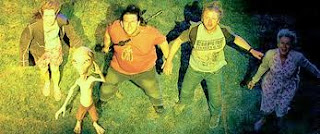The Civil War History of
the 57th Indiana (#16)
The Battle of Stones River, Tennessee
“Immediately there is activity among
the troops. Commanders of the brigades, regiments, and companies take their
places and the command ‘attention!’ is repeated from one to the other until it
reaches the men, who spring to their places in line. Colors are unfurled,
batteries are limbered, and in less time than it has required describing their
movements, the forces are ready for action.
“Soon a stream of demoralized soldiers
and non-combatants emerged from the woods on the right and broke to the rear.
They were quickly followed by ambulances, battery caissons, and loose horses
until there was one dense mass of commotion. Closely following after the rabble
that first
commenced leaving the field, came
hundreds of soldiers rushing by in confused masses and, to appearances,
entirely destitute of all regard for anything save their own personal safety.
Now and then we could see an officer or soldier who was using all his efforts
to induce his comrades to halt and to reform their lines. But all was of no
avail.
“Already the storm of battle was
bursting around us. Brave men were fighting hand to hand with the overpowering
force of the enemy. Rebel shells and bullets were whistling and whizzing
around, and our only hope was to secure and hold a position. Soon a battery got
into position and commenced shelling the advancing forces of the enemy. The 57th
moved to the corner of the woods and laid down near the battery to await the
onset of the enemy who were re-massing their infantry. A constant sheet of fire
streamed from the mouth of our guns, and in vain the rebels rushed forward with
maddened fury. But all their mad attempts were fruitless, and they finally
retired.
“‘Ah, I mow’d ‘em, I mor’n mow’d ‘em,’
said Capt. Cox. ‘I guess them fellows don’t want my battery as bad as they did.
If I had ammunition I could keep all the rebels back that could come before
us.’ Already the battery had fired sixteen hundred rounds; but their supply was
now exhausted, and the brave Cox was enraged at the thought of being compelled
to remain silent at the next rebel onset. The colonel told him that he thought
the infantry could hold them back if they should come before he could get a new
supply of ammunition.
“Temporary lulls in the fierce
engagements were succeeded by the renewal of the struggle with redoubled fury.
Occasionally during the rest of the afternoon, our regiment made some movement
of but a few rods and then resumed its position on the ground, as did all the
troops on the field. On our part of the field we had no shelter except such as
could be afforded by taking advantage of the ground. Slowly the hours passed as
we lay on the cold earth, the air filled with whizzing shells or solid shot. We
were anxious for night to come, for the progress of events plainly told us that
night alone would put an end to the conflict.
“Eventually the regiment was ordered
to the rear. As the regiment was moving, a rebel shell struck a man in Company
D in the back, and passed through his body, exploding just as he fell upon it,
blowing him almost to atoms. A portion of his arms were blown twenty or thirty
feet into the air.
“Information was received that the
enemy was preparing for one more powerful effort to drive us from our position.
‘They are bringing up their last reserve,’ said Col. Lennard, who was sitting
on his horse and viewing their movements. ‘If we can only hold them this time,
the day is ours.’
“As night came on, the roar of battle
died away and the two armies, worn out with hard fighting and heavy losses,
welcomed the darkness that invited a cessation of the bloody conflict. Until
near morning fires were not allowed, and during a considerable portion of the
night, we were obliged to stand in line of battle. Some men had mingled freely
with the enemy during the night, on the ground where the killed and wounded of
both armies lay. Some of the members of our regiment were rescued from the
place where they laid during the day. Slowly dragged the weary hours until
morning when the order was received to move. Marching some three quarters of a
mile to the rear, our arms were again stacked and large rail-fires built, at
which we warmed ourselves and cooked our breakfast.
“The terrible struggle of the previous
day had satisfied the enemy that we could and would fight, and though they had
well nigh succeeded in their attempt to take us unawares, there were still men
to contest their advances toward Nashville. The last day of 1862 will long be
remembered by the men who composed the Army of the Cumberland.”
(Tennessee, December,
1862)
Excerpts taken from “Annals of the Fifty-Seventh Regiment,
Indiana Volunteer Infantry: Marches, Battles, and Incidents of Army Life”
written by Asbury L. Kerwood immediately after the war.
































